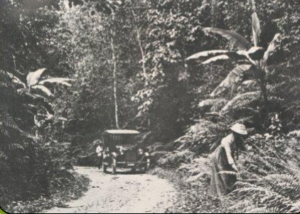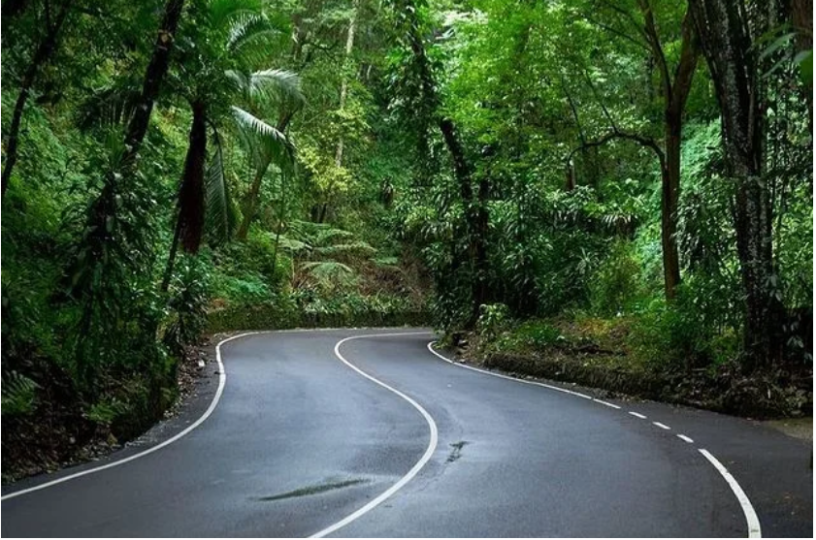Fern Gully, a lush, winding road near the resort town of Ocho Rios, is more than just a scenic drive; it is a journey through centuries of natural and cultural history.
Yet, as a child, I took Fern Gully mostly for granted. From my hometown of Colegate, the community directly above Fern Gully, it was simply a thoroughfare from where we lived into Ocho Rios, which, in my childhood, was nowhere as developed as it is today. Yes, I realized that Fern Gully was different from anywhere else I had been or seen, but it was just that, a place we knew just like any other. Though it held some level of fascination, and even terror. Local “robot” taxi drivers boasted of their driving prowess based on their skill in navigating its narrow, steep, winding path at high speeds, and even daring to overtake slower moving vehicles that proceeded more cautiously.
Fern Gully’s story begins long before human intervention. The area was covered by dense rainforest, home to a diverse array of flora and fauna. Believed to be the result of a prehistoric river that had long disappeared, it is alleged that the landscape dramatically changed after the 1907 earthquake that affected Jamaica.
The indigenous Taíno people, who inhabited Jamaica long before European colonization, likely used the area around Fern Gully for travel and resource gathering. The Taíno were known for their deep connection to nature, and the lush vegetation of the gully would have been a valuable resource for food, medicine, and materials.
During the Spanish colonization of Jamaica in the 16th century, the area around Ocho Rios, including Fern Gully, remained relatively undeveloped. It wasn’t until the British took control of the island in 1655 that more significant changes began to occur. The British established plantations and small settlements, but Fern Gully itself remained a natural corridor, largely untouched by the extensive agricultural development seen elsewhere.
Presbyterian missionary, Rev Hope Masterton Waddell, wrote of his experience traveling the route on his visit to the island in 1837-1838:
At Ocho Rios I turned towards the interior up a road which I was told would lead to Goshen where our brother Mr Jameson lately arrived had settled. It was called the “gully road” and was a strange and ancient looking way but whether a work of art or natural formation could not be known. Its name partly describes its character. It led inwards between ranges of forest clad hills and was walled on both sides by continuous lines of moss grown rock mantled with creepers like old ivy clad mason work. No stream flowed there nor was the way encumbered with loose rocks and masses of debris and heaps of sand like an old water course.
The transformation of Fern Gully into a roadway began in earnest in the early 20th century. Following the 1907 earthquake, the dried-up riverbed provided a natural path for a road. This road, which winds through the gully for about three miles, was paved and improved over the years, making it a vital route for travel between Ocho Rios and the interior of the island.

In the late 1970s, something remarkable happened. A small stream broke through the pavement and ran almost the full length of Fern Gully before disappearing somewhere on the Ocho Rios side. This lasted many months until, just as remarkably, the stream disappeared. Old timers asserted that it was the fulfillment of prophecy, that the long-lost river would return to reclaim its course. Vehicular traffic sloshed through the water as we traversed up and down the road.
One of the most remarkable aspects of Fern Gully is its incredible biodiversity. The gully is home to more than 540 species of ferns, as well as numerous other plants and trees. This rich plant life creates a canopy that envelops the road, providing a cool, shaded environment that is a stark contrast to the surrounding areas. The unique ecosystem of Fern Gully has made it a subject of interest for botanists and nature lovers alike.

Fern Gully’s natural beauty and unique environment have made it a popular destination for tourists. The winding road, with its towering ferns and lush greenery, offers a serene and picturesque drive. Visitors often stop to take photographs, or simply enjoy the tranquility of the gully. Local vendors along the route sell handmade crafts and souvenirs, adding to the cultural experience. One of the most popular characters was “Jack in the Bush,” an inspired idea from one of our townsfolk in Colegate who dressed himself in flowers and plants and allowed tourists to take pictures of him for tips.
Today, Fern Gully remains an important travel route and a beloved natural attraction. Efforts have been made to preserve its unique environment, recognizing its value not only as a tourist destination but also as a vital part of Jamaica’s natural heritage. The gully continues to draw visitors from around the world, who come to experience its beauty and learn about its history.
